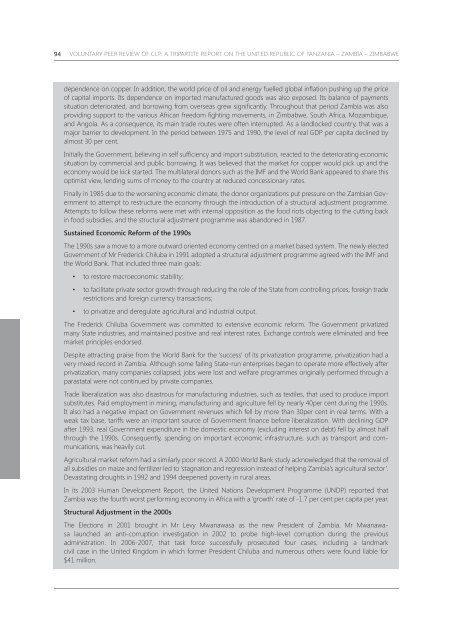a tripartite report - Unctad
a tripartite report - Unctad
a tripartite report - Unctad
You also want an ePaper? Increase the reach of your titles
YUMPU automatically turns print PDFs into web optimized ePapers that Google loves.
94 VOLUNTARY PEER REVIEW OF CLP: A TRIPARTITE REPORT ON THE UNITED REPUBLIC OF TANZANIA – ZAMBIA – ZIMBABWE<br />
<br />
of capital imports. Its dependence on imported manufactured goods was also exposed. Its balance of payments<br />
<br />
<br />
and Angola. As a consequence, its main trade routes were often interrupted. As a landlocked country, that was a<br />
major barrier to development. In the period between 1975 and 1990, the level of real GDP per capita declined by<br />
almost 30 per cent.<br />
<br />
situation by commercial and public borrowing. It was believed that the market for copper would pick up and the<br />
economy would be kick started. The multilateral donors such as the IMF and the World Bank appeared to share this<br />
optimist view, lending sums of money to the country at reduced concessionary rates.<br />
Finally in 1985 due to the worsening economic climate, the donor organizations put pressure on the Zambian Government<br />
to attempt to restructure the economy through the introduction of a structural adjustment programme.<br />
Attempts to follow these reforms were met with internal opposition as the food riots objecting to the cutting back<br />
in food subsidies, and the structural adjustment programme was abandoned in 1987.<br />
Sustained Economic Reform of the 1990s<br />
The 1990s saw a move to a more outward oriented economy centred on a market based system. The newly elected<br />
Government of Mr Frederick Chiluba in 1991 adopted a structural adjustment programme agreed with the IMF and<br />
the World Bank. That included three main goals:<br />
to restore macroeconomic stability;<br />
to facilitate private sector growth through reducing the role of the State from controlling prices, foreign trade<br />
restrictions and foreign currency transactions;<br />
to privatize and deregulate agricultural and industrial output.<br />
The Frederick Chiluba Government was committed to extensive economic reform. The Government privatized<br />
many State industries, and maintained positive and real interest rates. Exchange controls were eliminated and free<br />
market principles endorsed.<br />
Despite attracting praise from the World Bank for the ‘success’ of its privatization programme, privatization had a<br />
very mixed record in Zambia. Although some failing State-run enterprises began to operate more effectively after<br />
privatization, many companies collapsed, jobs were lost and welfare programmes originally performed through a<br />
parastatal were not continued by private companies.<br />
Trade liberalization was also disastrous for manufacturing industries, such as textiles, that used to produce import<br />
substitutes. Paid employment in mining, manufacturing and agriculture fell by nearly 40per cent during the 1990s.<br />
It also had a negative impact on Government revenues which fell by more than 30per cent in real terms. With a<br />
<br />
after 1993, real Government expenditure in the domestic economy (excluding interest on debt) fell by almost half<br />
through the 1990s. Consequently, spending on important economic infrastructure, such as transport and communications,<br />
was heavily cut.<br />
Agricultural market reform had a similarly poor record. A 2000 World Bank study acknowledged that the removal of<br />
all subsidies on maize and fertilizer led to ‘stagnation and regression instead of helping Zambia’s agricultural sector’.<br />
Devastating droughts in 1992 and 1994 deepened poverty in rural areas.<br />
In its 2003 Human Development Report, the United Nations Development Programme (UNDP) <strong>report</strong>ed that<br />
Zambia was the fourth worst performing economy in Africa with a ‘growth’ rate of -1.7 per cent per capita per year.<br />
Structural Adjustment in the 2000s<br />
The Elections in 2001 brought in Mr Levy Mwanawasa as the new President of Zambia. Mr Mwanawasa<br />
launched an anti-corruption investigation in 2002 to probe high-level corruption during the previous<br />
administration. In 2006-2007, that task force successfully prosecuted four cases, including a landmark<br />
civil case in the United Kingdom in which former President Chiluba and numerous others were found liable for

















